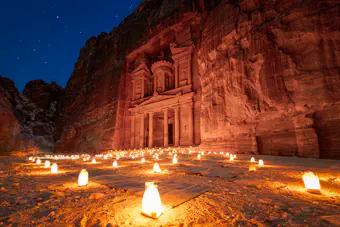Amman & Ajloun
Amman is Jordan’s largest city and is home to over 4 million people, which comprises 36% of the entire country’s population. It’s almost certainly the place you’ll fly into, and their baklava scene is the epitome of excellence. I recommend stocking up on a big batch to take around and eat on your trip and then another fresh one just before you fly out. An interesting fact about the city is that while there are city sewers, there are no municipal water lines! Every building has large white tanks on top of its roof and a truck comes around periodically to refill them. Water is often rationed, and many will use a cup to shower with to preserve water. This isn’t communicated at the hotels which I’m sure means tourists use a dispositionally large amount of water, although we did try to be mindful after learning that. Another interesting discovery was that instead of finding a Gideons’ Bible in the hotel nightstand, they have an Arabic Qur’an!
The first morning we met early at reception. The lobby TV featured what looked like a violent hostage negotiation being conducted, but we ignored that and dove straight into the local scene. We had a wonderful culinary experience at Mijana, plus they have a beautiful interior that continues the exterior illuminated street lights up to their fourth story dining room.
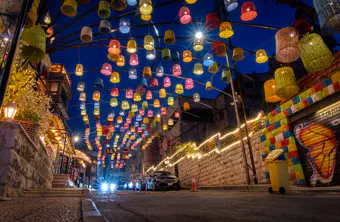
Amman is a massive city at 649 mi², so traffic can be horrendous depending on the time of the day. We walked around their night market near the restaurant before calling an Uber back to our hotel. On our way back, we witnessed a car crash into the side of a store. We wanted to go see if they were okay, but our driver just waved us off and said they’d be fine. 😯 The next morning, we headed to the Ajloun Castle which is a 12th-century Muslim castle that was originally used to control traffic along the road connecting Damascus and Egypt. The Ottomans came to use it during the 17th century.
We saved both the Citadel and the Roman Theatre for our return to Amman so the group joining us after first completing their Egyptian portion wouldn’t miss out. The Citadel has an impressive 360-degree view of the city and has been occupied by many different civilizations dating back to the Neolithic period. The ruins of the Temple of Hercules are still there along with the only remaining appendages of a statue of Hercules: his three fingers and an elbow. Did you hear the reason Hercules faced off with Cerberus? Someone triple-dog-dared him! 😂
The Roman Theatre dates back to the 2nd century and can seat 6,000. It’s regularly used as a venue for cultural activities. We visited on a day when it was open late and enjoyed the hike to the top and back down. We got the obligatory group photo at the end which was inevitably photo-bomed by a local kid. Heath and I also got a separate one with our kind and knowledgeable guide Faisel.
Jerash
We then headed to the Jerash Ruins which are famous for being one of the world’s best-preserved Greco-Roman ruins! You enter the site through the imposing 36-foot-tall Hadrian’s Gate with it’s triple arches—the large central arch for chariots and the two smaller archways for pedestrians. One was reserved for noblemen and the other was for commoners. I was awed by both the size and the intricately preserved detail. There were two amphitheaters both with incredible acoustics: the North Theater for the wealthy and the 3000-person South Theater for the poor. You can still walk the aisles of both today and even sing from the stage if you want. Even speaking softly gets amplified so that the entire amphitheater can hear you! There are also soaring temples dedicated to the gods of the day like Zeus, Athena, and Artemis. Colonnades line both the streets and the Hippodrome. Many of the religious site floors are covered with intricate tiled patterns. There was At its peak, Jerash was home to over 20k people. It’s believed an earthquake in 749 buried much of the city’s infrastructure and was abandoned soon after. The ruins lay buried for over 1000 years until a German researcher, Ulrich Jasper, discovered them in 1806.
I highly recommend wearing sunscreen and a hat. I skipped both which was a big mistake to make on the first day. There aren’t many roofs or areas of shade, so you’ll be in direct sunlight for the entire time you’re here, and you’ll likely want to spend a half-day exploring.
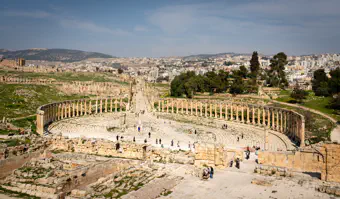
Wadi Rum - Valley of the Moon
We boarded a bus in Amman and began our 4-hour jaunt to the desert on the southern border. When we stopped at a rest stop/trinket emporium a few of us purchased scarves known as keffiyeh which we modeled before hopping back on the bus. Since I had gotten badly burned on my first day, I was determined to wear as much protection as possible for the rest of the trip. You can just call me Muad’Dib because I’ve got the spice! I later learned that each country has its own color identity when I was complimented in Egypt for my Arabian scarf; they suggested I purchase a white Egyptian replacement. 😆
The Wadi Rum Protected Area has been a UNESCO World Heritage site since 2011. It’s a popular location for filming, so you’ve probably seen its impressive landscapes in movies like Dune, The Martian, Aladdin, and Star Wars among 46 others! There are many varied camp experiences in the area including the popular albeit expensive Mars Camp where you stay inside a white “Martian” dome tent. We stayed at the more economical Captain’s Camp. It qualified as a glamping experience since there was indoor plumbing, but we were missing a toilet seat in our room so that made for a fun experience.
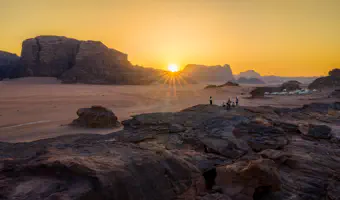
After our guide checked into our camp, he left with the bus to pick up the group from Egypt who had taken a boat from Dahab traversing the Gulf of Aqaba. We had the afternoon to explore and relax. The rest of our group paid $17 USD for a camel ride. Since I’ve been on a camel ride through the Sahara, I abstained. I did go to take pictures for the rest of the group. If you’ve never been on a camel before, they are quite tall, so the easiest way to mount one is for the camel to first kneel. It’s important to lean back as they get up because they raise their hind legs first which momentarily positions the rider into a precarious tilting position. One of our group members hadn’t quite mastered this technique, which turned from horrification to humor after learning that both she and the camel were okay. My brother Heath later narrated that he heard me slowly taking pictures at first with a “click…..click…..click”, but as she began to topple forward he noticed my rhythm changed to a “clickclickclickclickclick”. 🤷 I have no defense, but I am a fan of some of the facial expressions I captured at that moment!
We went on a sunset hike and returned to camp awaiting the arrival of the rest of our group. When they arrived hours late, they told us that their boat from Nuweiba, Egypt didn’t have a specified time of departure—it left only once it was full. So they had been sitting in the port for hours before evening starting their hours-long voyage. The camp staff had prepared a traditional Bedouin feast for us: Zarb. It’s a technique where the meal is prepared underground for many hours. There was lamb, chicken, carrots, and onions that were put in a container in a deep hole which was subsequently filled with hot coals and sand. Then blankets were put on top to trap even more heat. The result was juicy, tender meat infused with the essence of vegetables and smoke. And then there were more sauces than I could identify to add even more flavor. It was a delicious end to our day.
The next morning we went on a ride through the desert where we saw ancient petroglyphs, climbed a massive dune, and hung out with a caravan of camels. We then departed for Shobak Castle where we got a quick tour. It was built in 1115 and was strategically placed on an imposing hill that helped with its defense. We continued our drive to the crown jewel of Jordan.
Petra: The Rose City
While the area around Petra was inhabited as early as 7000 BC, historians believe the Nabataeans likely settled there in the 4th century BC. They established the city as a regional trading hub for the lucrative incense trade routes. This brought them great wealth and the city peaked at ≈ 20k. The Roman Empire annexed the Nabataean kingdom in 106 AD. It was later lost to time to most of the world. Only Bedouins knew its location, so in the early 1800s, a Swiss explorer named Johann Ludwig Burckhardt disguised himself as an Arab scholar and conned his way to the site. This reintroduced the site to archeologists and travelers worldwide. It has been a UNESCO World Heritage Site since 1985 four years before Indiana Jones and the Last Crusade was famously filmed there. You might recognize it as the fictional Canyon of the Crescent Moon. While Indy retrieves the Holy Grail from deep within the Treasury in the movie, it’s actually nothing more than a facade with a relatively small hall that was once used as a royal tomb. In 2007, it was named one of the new seven wonders of the world.
We started the day with a delicious spread at The Petra Moon Hotel before heading out to experience Petra. Our guide led us through the Siq showing us how the Nabataeans carved channels along the entire Siq to collect and transport water away from the city. There were also high passes carved into the walls that allowed for the defense of the city in case of attempted invasion.
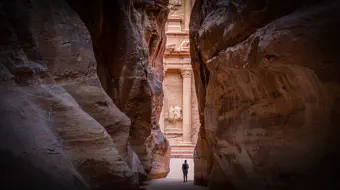
The foresight of the stonemason who meticulously carved The Treasury within the pink sandstone cliff has safeguarded its existence for millennia, shielding it from the erosive forces of nature. Prescience at its finest. 🙏
We admired the majesty of the Treasury area before splitting off into smaller groups to explore. Bedouins pushed hard to sell us an accent up an excavated a path reaching halfway up the cliff to the side of The Treasury, but I had researched a much longer path leading to the top of the cliff. Heath and I quickly headed in that direction to get to the top before the extreme midday sun since it was an exposed path. We did get distracted along the way by a large amphitheater, several other partially-eroded buildings, and “stairs” that were more of a blend between stairs and a slide thanks to the years of erosion and foot traffic. When we did make it to the top, a Bedouin had conveniently pitched his massive tent on the ledge completely blocking out any view of the Treasury. You could go inside, but signs made it known a drink purchase was a requirement of entry. ☕
After getting our photos and making our way back down to the canyon floor, we headed out to accomplish our second objective: hiking to the largest monument of Petra—The Monastery. The winding, mountainous path contains around 850 uneven, oddly spaced steps, so its best to take your time and take breaks. That’s easy to do since almost every other step is a local shopkeeper hawking trinkets and treats. And once you get to the top, there’s a whole restaurant area. We learned that many of the locals live there and only come down for supplies once or twice a week.
It is an impressive monument at 50 meters wide and 45 meters tall. The interior is large but also off-limits, so we just peeked inside. There are several mini-hikes at the top to get to interesting views overlooking the Monastery. My favorite was from inside a cave that provided a nice frame from which to photograph.
On our way down, we succumbed to the heat and exhaustion and took an ice-cream break. We snapped a few last photos on our way back past the Treasury before the long walk back to the hotel. We splurged on a $12 USD buffet that contained some very impressive food. I found both the staff and facility of the The Petra Moon Hotel impressive. It was the nicest hotel of the trip and not just that the previous night we were staying in a tent in the desert. Although that contrast may have subconsciously influenced me a tiny bit.
Three times a week, “Petra by Night” takes place and the entire Siq and Treasure are lit with over 1,500 “candles” ( I checked the bags to find electronic bulbs). It’s an extra $25 for the ticket, but the Treasury illuminated by candles was my original inspiration for booking the entire trip, so there was no choice. I got my ticket early and stood in line about 30 minutes before it opened. There were about 20 people ahead of me, but I sped-walk most of the way there only half tripping a few times in the dark. There was one snide remark made about me not enjoying the experience, but little did he know that I was rushing so I could enjoy the experience of having an empty Treasury area for about 2 minutes. Since my shutter speed was a whopping 30 seconds, and I had to find a spot to set up my tripod, this meant I got just 2 images before the hordes started descending, but that was enough! I cleverly cropped and Photoshopped out the few people and chairs that did make their way into my images, so if you go yourself, know that you’re going to share the environment with hundreds of other people. A cautionary note: sit on the chairs and not the mats. Cats roam the area and enjoy using the mats for their business. 🤢
The next morning as our group began loading the bus, Heath and I jogged back down to the museum just outside the entrance to get a picture with the sign and the colorful sunrise before heading back north to Amman. 👬❤️
The Dead Sea
We stopped at the Holiday Inn Resort on the Dead Sea to experience the lowest point of dry land on Earth. The mud there ostensibly has medicinal benefits, and the resort stocked large vats of it on the beach. After floating for a bit, we caked ourselves in it. It is an unnatural feeling to “sit” in the water and stay there with no effort. We were warned against submerging our faces because a mouthful of water with a salinity level of 34% is not great for one’s health. It’s about eight times saltier than the ocean which makes it incredibly dense.
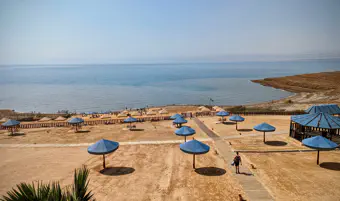
After a very thorough shower to get rid of all the salt, we enjoyed a buffet lunch before heading back to Amman for our final night in Jordan. The next morning we went straight to the airport for our international flight to Egypt, and the beginning of the next leg of our trip.
Here’s a link to our trip notes in case you’d like more details or to pull things from our itinerary. We went with Travel Talk Tours on their Ultimate Jordan & Egypt trip. It doesn’t look like that exact itinerary is offered any longer, but you can probably find something similar here.
